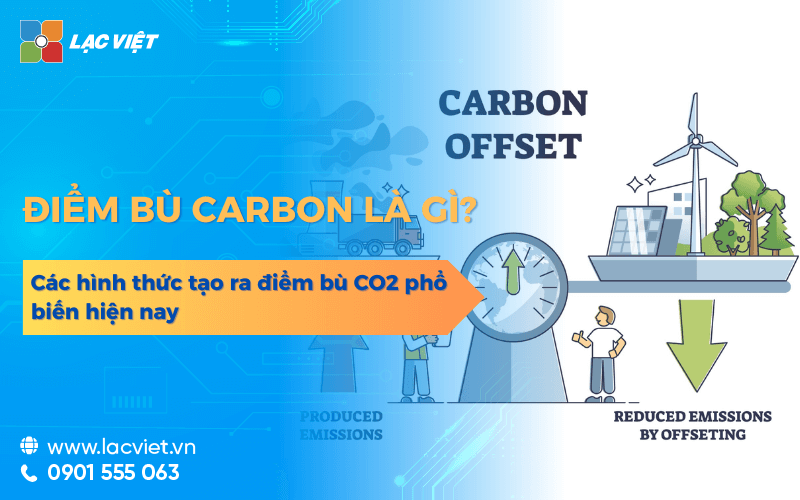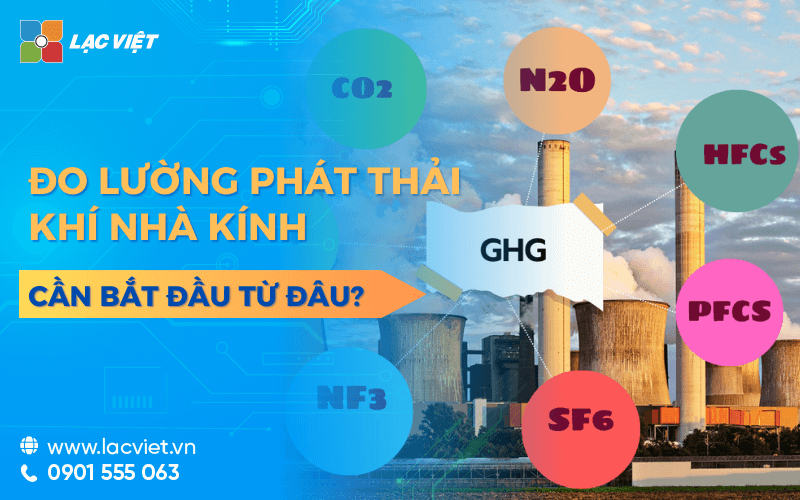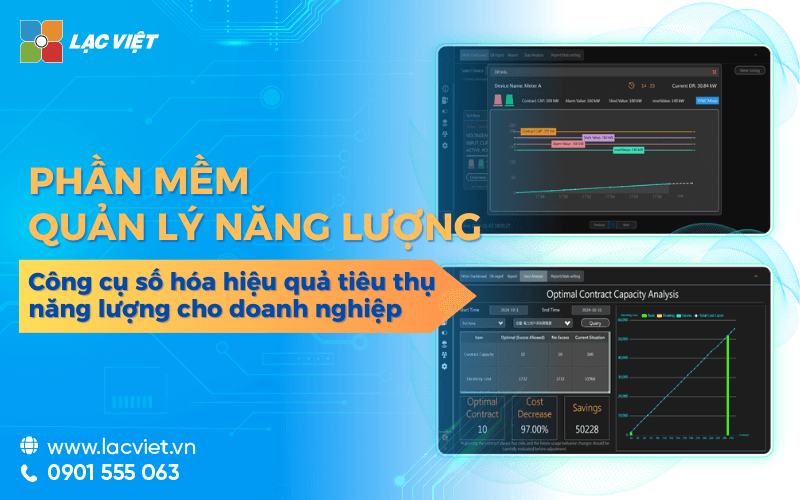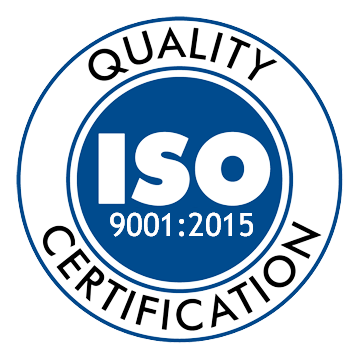In the context of business increasingly under pressure to reduce greenhouse gas emissions, “point offset CO2” is becoming an important concept, especially for those units not yet able to fully cut emissions at home. So the offset CO2 what is? Why essential role in the journey towards the goal of emissions to net 0 (Net Zero)? The same Lac Viet Computing find out details in this article.
1. Point offset CO2 what is? Explains concepts in understandable manner
1.1. Definitions easy to understand about the offset CO2
Point offset CO2 (carbon offset point) is a unit of measurement expressing the amount of CO2 has been “offset” or removed from the atmosphere, to neutralize the emissions that the business or organization created in other places. Simply said, if a business emissions of 1 ton of CO2 in the production process, they can “offset” the amount of emissions that by investing in an activity or project to help reduce emissions equivalent to 1 tonne of CO2 elsewhere.
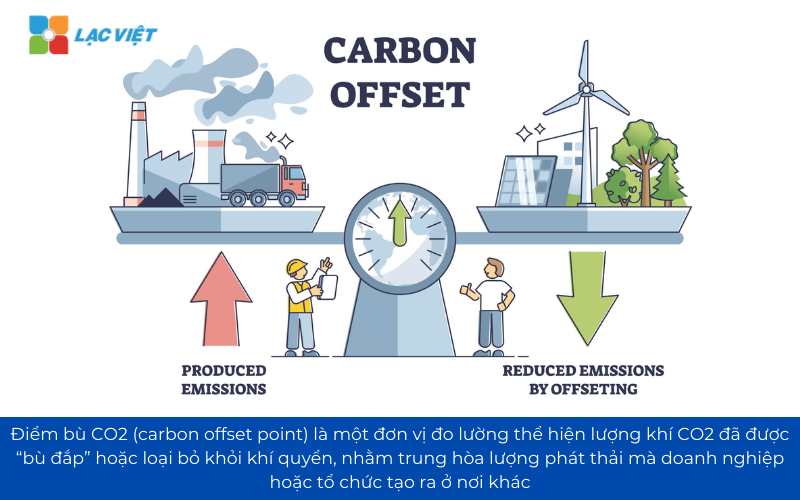
Illustrative examples:
Imagine the business you operate a plant, used oil burners cause emissions of 100 tons of CO2/year. Despite optimization technology, you still can't reduce this number down lower. Instead of continuing to emissions exist, you invest in a reforestation project in the local place has the ability to absorb 100 tons of CO2 per year. Meanwhile, emissions of you have been “offset” in an indirect way – and the offset that was recorded into “point offset CO2”.
This operation does not disappear CO2 you have been discharged, but helps to balance the emissions with a positive action valuable environment equivalent.
1.2 why point offset CO2 is important in the roadmap Net Zero of the business?
Not every enterprise can also cut emissions to 100% in the short term. Some industries such as cement, steel, aviation, etc. always has a part in emissions “difficult to remove” due to the peculiarities and specifications. In that case, point offset CO2 is the practical solution to handle the emissions remaining without breaking commitments to reduce emissions comprehensive.
Moreover, the system reports such as the GHG Protocol, the international standards on ESG are recognized point offset CO2 valid if is evidenced by data transparency unit independent verification. This helps businesses:
- Ensure compliance with current regulations
- Market participants credit only voluntary carbon
- Enhanced credibility with investors/partners
1.3. Difference between “point offset CO2” and “carbon neutral”
Here are two concepts are often confused. Carbon neutral (carbon neutrality) is the state where the total emissions net of 0 – i.e., the emissions will be offset entirely by the active absorption or removal of CO2.
Meanwhile, point offset CO2 is the tool to achieve the goal carbon neutral, through the activity measurement can be verified. Businesses can use a section point offset CO2 outside to supplement the efforts to reduce emissions intrinsic to move closer to the goal of Net Zero.

1.4. Distinguish “carbon offset” and “carbon credit” – to avoid confusion
Although the two terms are often used interchangeably, but in essence, they are the difference:
- Carbon offset: is the action or project implementation in order to reduce or eliminate CO2 emissions. For example, construction solar power plant, plantation, process improvement cleaner production.
- Carbon credit: a financial unit represents 1 ton of CO2 is removed, can trade on the market. Each project offset when certified will create the carbon credit – and business can be acquired to compensate for emissions of yourself.
Properly understand this difference helps businesses:
- Know how to choose project offset matching target
- Active market participants credits carbon all the way
- To avoid confusion between environmental values and the financial value of the activity offset CO2
- Scope 3 Emission is? Comprehensive guide to measuring and managing emissions indirect
- CBAM is what? What should prepare to cope with adjustment mechanisms border carbon of the EU?
- Carbon Neutral is what? Roadmap to help businesses achieve carbon neutral
- Carbon Footprint is? Calculate, reduce the Carbon footprint for your business
2. The form created point offset CO2 popular today
When a business can't fully cut emissions intrinsic in the creation or acquisition of point offset CO2 is a strategy that support important to get closer to the target emissions net of 0. Here are three groups form the offset CO2 popular easy-to-apply today:
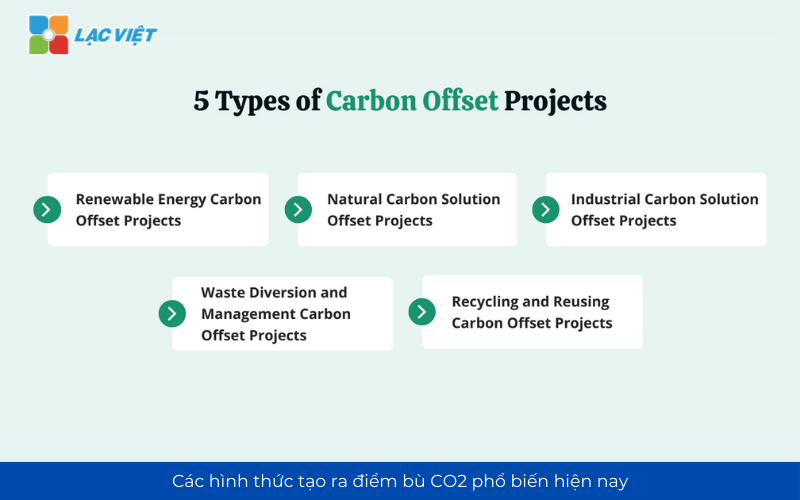
2.1. Reforestation project, restoration of natural forests
Forest plays an important role in the absorption of CO2 through photosynthesis. Each hectare of forest is able to absorb from 10 to 30 tons of CO2 per year, depending on tree species, age and growth conditions. Therefore, the project of planting new forests or forest restoration nature is one of the solutions offset CO2 is applied most widely in the world.
Practical examples: A business can partner with organizations for conservation of nature to finance plantation in the hill area, gay, or land degradation. After the project is deployed units, independent inspection will assess the amount of CO2 that forest which has the ability to absorb each year. Since then, business will be recorded score offset respectively.
Business benefits received:
- Contribute to improve biodiversity, ecosystems, local
- Can take on reporting ESG as a specific action to reduce emissions
- Increase brand reputation, particularly when operating in the industry can affect the environment such as mining, manufacturing, building materials, consumer goods
2.2. Project renewable energy (solar power, wind power)
Production of electricity from solar or wind does not generate CO2 gas, whereas electricity from coal, oil or natural gas re-emission significantly. So, investing or financing the projects of renewable energy can create point offset CO2 through the emission is “avoid” (avoided emissions) when not in use fossil fuels.
Illustrative example: A business investment, construction solar power system on the roof of the workshop. In a year, this system produced 100,000 kWh of electricity, replacing the equivalent amount of electricity from the national grid (which the majority coming from the source fossil). Based on the emission of grid (for example: 0,913 kg CO2/kWh in Vietnam), businesses can offset approximately equivalent to 91.3 tons of CO2 per year.
Business benefits received:
- Reduced electricity costs in the long run, at the same time create value offset CO2 clear
- Increased accessibility concessional loans, financial green from the investment and development fund
- Can register credits carbon if the project reaches the international standard such as Verra or Gold Standard
2.3. Projects, energy-saving, improve the production process
Not necessarily planting or construction of wind power plants, business can still generate points offset CO2 from the optimization of the operating system out there, as long as there is a measurable emissions have been reduced compared to before.
Some typical example:
- Replace boiler industrial old new kind consume less fuel than
- Transition from gasoline cars to electric vehicles in operating internal
- Re-use waste heat in the machine to reduce energy consumption, new
- Automation line help reduce the number of hours of operation, thereby saving power
Conditions to be noted point compensation:
- There are metrics measure specific emissions before and after improvements
- Can prove that the emission reductions are real, verifiable,
- Should be verified by independent unit if businesses want to use for the purpose of certification ESG or release credits carbon
Business benefits received:
- Save operating costs through the use of more energy efficient
- Emissions in reporting GHG and increase the ability to meet international standards
- Create advantages when participating in the tender for export to markets with environmental standards rigorous as Europe, Japan, America
Summary business values received from the form of the offset CO2
| Form offset CO2 | Direct benefits | Benefits indirect |
| Reforestation, forest restoration | Recorded point offset clear, increasing the value of the environment | Increase sympathy from the community, enhance brand image |
| Renewable energy | Reduce the cost of electricity, generating clean electricity can measure | Easy access to capital deals, gaining ESG |
| Save energy, process improvement | Optimal operating costs, reduce emissions, reality | Support independent record Net Zero emissions reporting reliable |
3. Business can use points to offset CO2 how?
The use of point offset CO2 is not merely a form of “buy to clean traces” emissions, which should be considered as part of a strategy to reduce emissions comprehensive managed basically transparent. Depending on the scale and orientation, the business can choose one in three following directions or a combination of flexibility to optimize the performance.
3.1. Market participants credit only voluntary carbon
One of the most popular ways to use points to offset CO2 is buy credits carbon (carbon credits) from the project has been internationally recognized. Each credit represents 1 ton of CO2 has been reduced or removed from the atmosphere is granted by the intermediary organizations independent transparency.
Practical benefits:
- Businesses do not need to deploy the project, but still can record the offset CO2 accurate valid in reported emissions.
- Match the business can fund green investment but lack the space or infrastructure to deploy internal.
- Easily integrated into strategies for sustainable development, in particular when businesses need to demonstrate commitment to Net Zero with customers and partners.
A number of standard reputation in the international market:
- Verra (VCS): Certified projects that reduce emissions from forests, renewable energy, agriculture,...
- Gold Standard: Ensure the project will not only reduce emissions but also create social value and community.
- CDM (Clean Development Mechanism): the united Nations development, in accordance with the developing countries.
Practical example: A company producing textiles in Vietnam can buy credits CO2 from wind power projects in India to compensate for the emissions cannot be cut due to the peculiarities industry.
3.2. Create point offset CO2 internal
If the business is conditional on infrastructure, land or the ability to deploy technology, the initiative to create point offset CO2 from the operation of his will bring many long-term benefits, both in terms of cost and brand.
A number of the form:
- Planting in industrial areas or land owner
- Installation of solar power attic, alternative means running fossil fuel to electric cars
- Re-use waste heat, improved devices drain more power
How to record a point offset CO2 internal:
- Businesses need to perform the measurement of emissions before and after improvements from that calculate the amount of CO2 reduced.
- Results should be stored. If possible, it should be verified by the Tuesday to increase reliability when put into the report emissions or report ESG.
Benefits highlights:
- Reduction depends on the market just outside
- Increase the ability to control the transparency data
- Can be used for internal communication, increase the mount's commitment to employees
3.3. Integrated point offset CO2 on reporting ESG and brand strategy green
Point offset CO2 not only value the environment, but also is a clear evidence to proven enterprise committed to sustainability in profile, capacity, especially in areas with international standards as high as exports, foreign investment, banking and finance.
Practical application:
- Put information point offset CO2 into report ESG to improve the review score
- Integrated in the tender document international records called capital or IPO
- Use as part of a media campaign, brand blue, contribute to building a business image, responsible, long-term vision
Business benefits received:
- Creating competitive advantage clearly in the market are regulated emissions strict (for example: European, with adjustment mechanisms border carbon – CBAM)
- Increase opportunities for cooperation with global partners are applying standard Net Zero in supply chain
- Meets the requirements of increasingly stringent from the investment fund, ESG, financial institutions, international
4. Enterprise value received when use strategy to offset CO2 efficiency
Apply strategies to offset CO2 does not only mean the environment, but also the leverage practices to help businesses enhance the ability to adapt to competition in the context of trends in sustainable development has increasingly become a global standard.
4.1. Compliance with the standards, the international emissions
Many businesses today have been and are being asked to report emissions under the international standards such as the GHG Protocol, or according to the route Net Zero by government or partner given. The use of point offset CO2 valid is legal manner transparent to:
- Reducing emissions to net in the report
- Meet the criteria in the program audit ESG or evaluation of supply chain
Instead of facing the risk of being excluded from the global supply chain, businesses can proactively demonstrate efforts to reduce emissions by specific data, through the point offset CO2 was recorded verification.
4.2. Minimize risks from policy on taxes and quotas on carbon
The policy on the carbon tax, quota emissions and adjustment mechanism carbon at the border (CBAM) is gradually in force in many countries, especially in Europe. Business if not prepared in advance will:
- Faced with the cost of emission increase
- Take advantage of price when exporting goods
Use points to offset CO2 properly helps business to maintain the ability to export stability to avoid the additional costs arising from the excess emissions.
4.3. Increase the review score of ESG branding green solid
Investment funds, financial institutions, present not only interested in profit, but also business reviews based on the index ESG. Business strategically reduce emissions clear, transparent will:
- Easy access to capital with preferential interest rates
- Increased credibility in the process called capital, IPO or international cooperation
In an era where consumers and partners are interested in environmental responsibility, the use of point offset CO2 is specific evidence for commitment to sustainable development. This is especially valuable in industries such as food, consumer goods, export products...
5. The note when choosing solutions to offset CO2 for business
The deployment strategy to offset CO2 efficiency need to be cautious. If the business approach is not the right way, the purchase of credits, carbon can become expensive, lack of value even cause negative impact to reputation. Here are the rules to note:
Avoid credit carbon of unknown origin
Currently, market, credit, only carbon has many projects are not clearly verified or does not meet international standards. Business should avoid:
- Buying credits no side Tuesday accreditation
- Project no transparency about measurement method authentication
Instead, let's choose credit be released according to the standard reputation as Verra (VCS), Gold Standard, or national standards are clearly defined.
Priority projects create value dual (environmental and social)
Instead of just focusing on the amount of CO2 is offset, businesses should prioritize the project:
- Create jobs for the community
- Improve livelihoods, conservation of nature
- In accordance with the direction ESG comprehensive
This does not only increase the value for credits but also help business communication more effective social responsibility.
Combine reducing emissions internally to offset CO2 outside
Strategic sustainability ideal is not to “buy points offset to delete traces”, which is:
- Maximize efforts to cut emissions internal
- Combined offset CO2 for the emission can not remove
This approach is just cost-effective, newly created platform to operate long-term sustainability.
Ensure transparency, verifiable,
All operations offset CO2 should be recorded, reported and can check is by stakeholders. This helps:
- Increase reliability in reporting ESG
- Avoid risks when under audit or inspection from partner
- How to calculate credits carbon and the method applied to calculate credits carbon
- Business how to get credits carbon accordance with international standards?
- Coefficient of Co2 emissions according to the IPCC and any conversion of the form of energy
- Net Zero is what? Roadmap 2050 and solution goal commitment
6. Situation apply the offset CO2 in Vietnam and opportunities for business
In the last few years, Vietnam has implemented a number of projects credits carbon fact, such as:
- Reforestation project in Quang Nam, Hue
- Power projects, biomass from agricultural products
- Project biogas in the livestock area, big
These projects show the potential of Vietnam in the creation of point offset CO2 legally, can participate in the international market.
The government is finalizing the legal framework. Today, Vietnam is in the process of:
- Building system trading credits carbon interior, with expectations official operation from the year 2028
- Join pilot mechanisms credits international as CORSIA (aviation), CBAM (export to Europe)
- Released Decree guide management emission credits carbon (approved by the Ministry of Environment and natural resources submitted by The government)
This is a positive signal for the business, especially the export sector, big. The business actively deployed soon there will be advantage:
- Easy access to the investment incentives, support from the organization for international development
- Take on the role of lead in sustainable supply chain
- Take advantage policy switch blue of The water to increase the capacity of long-term competitive
The applied strategy to offset CO2 properly not only support business compliance with international standards, but also opens many opportunities for market access, investment and global partners. In particular, in the context of Vietnam is taking steps to improve the legal framework for market, credit, carbon, then the pioneer enterprise deployment from the early will have the advantage pronounced on the long-term.
Switch blue is no longer the choice – which is the indispensable requirement of sustainable development. And point offset CO2 is the smart solution for businesses to overcome technical barriers, closer to target Net Zero a proactive, transparent effect.

